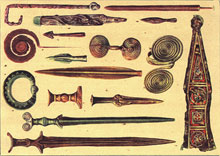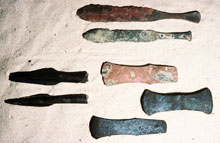From Copper to Bronze to Conquest
The word copper comes from the Latin word cuprum, which was used to describe the unique bluish-green metal that dotted the landscape of the ancient world and greatly influenced the primary cultures of Mesopotamia, Egypt, Greece and Rome. Neolithic humans about 10,000 years ago first used native copper as a substitute for stone. A copper pendant discovered in what is now northern Iraq has been dated to about 8700 B.C. For nearly five millennia copper was the only metal known to man, and thus had all the metal applications.
Evidence of copper's use throughout history can be found in artifacts from around the globe - from Asia and the Middle East to South America and even the present-day United States (over 7,000 years ago, Native Americans mined and used copper in what is now Michigan). As a result of copper, mankind's "oldest metal," the art and craft of metalworking spread into almost every facet of life, from currency to tools to ornaments and, especially, weaponry.
The Need for Bronze
For ancient artisans, copper's malleability in its natural, pure state was a major attribute, but this quality had significant drawbacks when it came to producing armaments. Swords and spears made from copper could be easily sharpened, but they were unable to hold their edge for very long.
This led to experimentation and, ultimately, to the creation of alloys that combined the best qualities of two or more metals. When early metalsmiths discovered more durable metal with performance attributes beyond anything they had ever known, the Bronze Age began. It is believed The discovery of bronze and brass (a fusion of copper and zinc) had a twofold effect on ancient societies - it fostered both trade and warfare. As a result, these immeasurably useful metals became basic requirements needed to protect, improve and expand ancient civilizations. The need for copper, tin, zinc and other metals inspired societies and led to a number of extraordinary events that forever changed the course of the world.
Bronze played a key role in the rise and fall of civilizations. In 2350 B.C., the warrior king Sargon I and his bronze-equipped armies conquered the city-states of Sumeria and united them into a vast kingdom with the fabled city of Babylon as its center. Around 1500 B.C., the Troy of Homer's Iliad, located in the southwest corner of modern-day Turkey, was an epicenter of bronze activity due to its proximity to copper and tin deposits, as well as its strategic location astride key land and sea trade routes. During that era, the ocean-faring war machine of the Phoenicians relied on copper cladding and bronze for its ships and weaponry. When they conquered the city of Byblos in modern-day Spain, the confluence of cultures resulted in one of mankind's greatest contributions, the creation of the alphabet.
The Bronze Age lasted for more than 1,500 years, from 2500 B.C. to 1000 B.C., and although it centered on the region stretching from the Mediterranean to the Middle East, the influence and effects of bronze were not limited to this area. Records and artifacts also show extensive copper and bronze usage throughout Asia as far back as 2600 B.C. The copper and bronze trade extended north along the Danube River and opened a gateway into central Europe and beyond.
Advancements in metalworking eventually led to the discovery of iron and the dawn of the Iron Age. And though copper and brass were no longer the dominant metals of the era, their impact on the world continues today. Computers, automobiles, airplanes, motors and other modern devices that power our lives wouldn't be possible without the contributions of copper and brass. Cu
Resources:
Also in this Issue:
- Wind Power: A Positive Future
- Motor Rotors
- Flex Copper Circuits: Clean and Conductive
- From Copper to Bronze to Conquest
- CPUs Reach Their Potential Through Copper: The Hottest Computers Depend on Copper

 Bronze age weapons from Eastern Europe.
Bronze age weapons from Eastern Europe. Bronze tools and weapons found in modern-day Turkey.
Bronze tools and weapons found in modern-day Turkey.  Bronze arrow from the 7th BC in modern-day Pakistan
Bronze arrow from the 7th BC in modern-day Pakistan